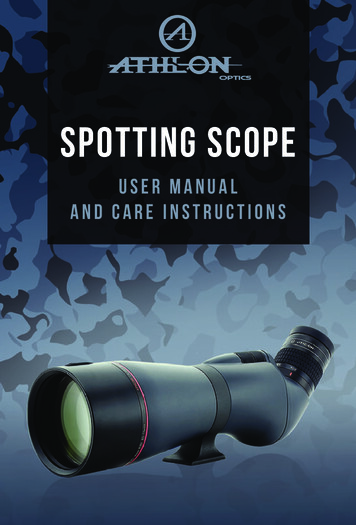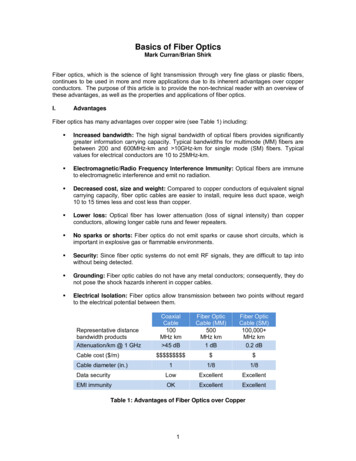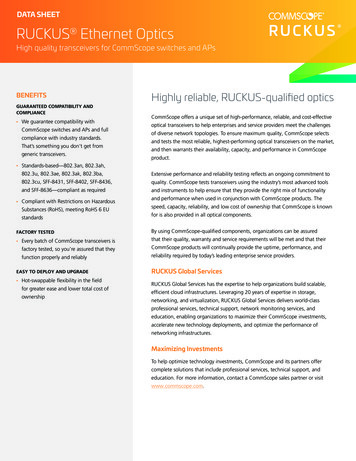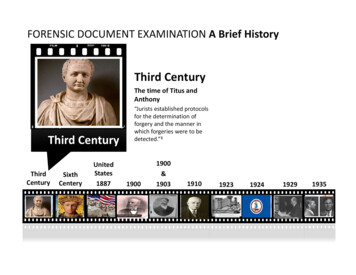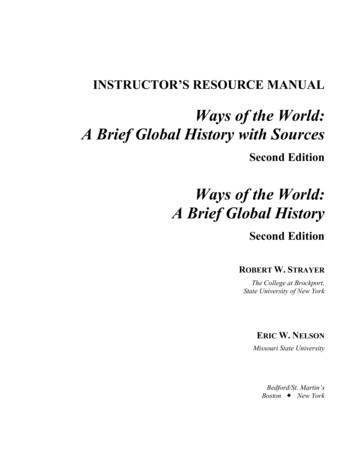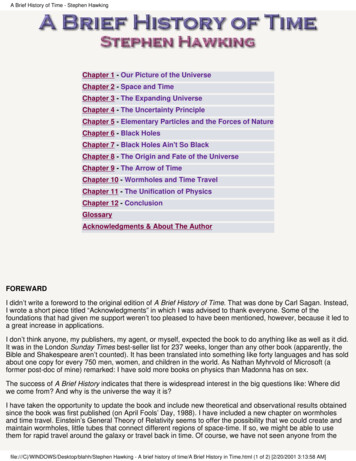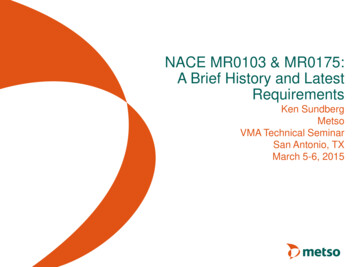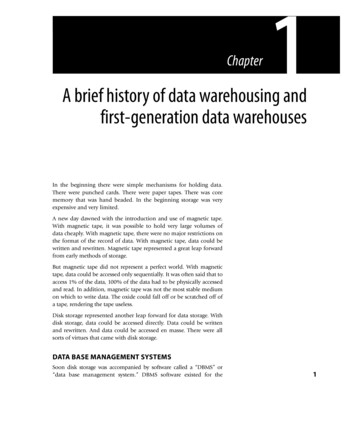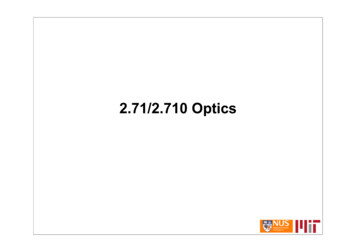
Transcription
2.71/2.710 Optics
2.71/2.710 Optics Instructors: Prof. George BarbastathisProf. Colin J. R. SheppardAssistant Instructor: Dr. Se Baek OhTeaching Assistant: José (Pepe) A. Domínguez-CaballeroAdmin. Assistant: Kate AndersonAdiana AbdullahUnits: 3-0-9, Prerequisites: 8.02, 18.03, 2.0042.71: meets the Course 2 Restricted Elective requirement2.710: H-Level, meets the MS requirement in Design“gateway” subject for Doctoral Qualifying exam in OpticsMIT lectures (EST): Mo 8-9am, We 7:30-9:30amNUS lectures (SST): Mo 9-10pm, We 8:30-10:30pmMIT 2.71/2.71002/06/08 wk1-b- 2
Image of optical coherent tomographyremoved due to copyright restrictions. Please see:http://www.lightlabimaging.com/image gallery.phpMIT 2.71/2.71002/06/08 wk1-b- 3Images from Wikimedia Commons, NASA, and timbobee at Flickr.
Natural & artificial imaging systemsImage by NIH National Eye Institute.Image by Thomas Bresson at Wikimedia Commons.Image by hyperborea at Flickr.MIT 2.71/2.71002/06/08 wk1-b- 4Image by James Jones at Wikimedia Commons.
Image removed due to copyright restrictions.Please see JV2Wallpaper.jpgMIT 2.71/2.71002/06/08 wk1-b- 5
Class objectives Cover the fundamental properties of light propagation and interactionwith matter under the approximations of geometrical optics and scalarwave optics, emphasizing– physical intuition and underlying mathematical tools– systems approach to analysis and design of optical systemsApplication of the physical concepts to topical engineering domains,chosen from– high-definition optical microscopy– optical switching and routing for data communications and computerinterconnects– optical data storage– interface to human visual perception and learningMIT 2.71/2.71002/06/08 wk1-b- 6
What you need Absolutely necessary– Euclidean geometry, trigonometry– calculus with complex variables– Taylor series approximation– MATLAB or other computation/visualization software– linear systems (2.004 level, we will extensively review)Helpful if you know but we will cover here– basic electrodynamics (Maxwell’s equations)– basic wave propagation– Fourier analysisMIT 2.71/2.71002/06/08 wk1-b- 7
Learning resources Announcements, notes, assignments, solutions, links, broadcastTextbooks:– “Optics” by E. Hecht, 4th edition (Addison-Wesley)– “Introduction to Fourier optics” by J. W. Goodman, 3rd edition(McGraw-Hill) Other recommended texts:– “Waves and fields in optoelectronics” by H. A. Haus– “Optics” by Klein and Furtak– “Fundamentals of photonics” by Saleh and Teich– “Fundamentals of optics” by Jenkins and White– “Modern Optical Engineering” by W. J. Smith Experimental demonstrations (in class, almost weekly)MIT 2.71/2.71002/06/08 wk1-b- 8
Administrative: 2.71 Grade: 30% homeworks, 30% quizes,40% final examEight homeworks– each due 3 lectures after post date (see syllabus)– see website for collaboration & late policies– mainly “comprehension” problemsMIT 2.71/2.71002/06/08 wk1-b- 9
Administrative: 2.710 Grade: 30% homeworks, 20% quizes, 20% project,30% final examEight homeworks– each due 3 lectures after post date (see syllabus)– see website for collaboration & late policies– both “comprehension” and “open-ended” problemsProject– teams of 3-5– two project types: I. Read & Lecture; II. Research– selected among one of available topics or self-selected– start early March– weekly or so info meetings with project assistants– oral presentation on Weds. May 6MIT 2.71/2.71002/06/08 wk1-b- 10
Administrative: both Two quizes:– Quiz 1 on Monday March 9th, in class content: geometrical optics– Quiz 2 on Monday April 27th, in class content: scalar wave opticsFinal exam:– scheduled by the Registrar– comprehensive on all material covered in classPractice problems will be available before each quiz and the finalAbsence from quizes/final: Institute policies applyGrading: Institute definitions applyMIT 2.71/2.71002/06/08 wk1-b- 11
Administrative: both (cont.) Please study lecture notes and book reading assignmentsbefore class Questions: the most important part of learning– In class– During office hours (time/location TBA)– After hours: please use course discussion web site – No email Logistic/administrative questions: please email instructor team (fasterresponse) No recitations– Some math revision sessions scheduled Mo or We, 7pm (MIT only)– In class problem solving in teamsMIT 2.71/2.71002/06/08 wk1-b- 12
Topics Geometrical optics– Basic ray-tracing– Image formation and imaging systems– Advanced ray-tracing: Hamiltonian optics– Optical system designWave optics– Scalar linear wave propagation– Wave properties of light– Polarization– Interference and interferometers– Fourier/systems approach to light propagation– Spatial filtering, resolution, coherent & incoherent image formation,space-bandwidth product– Wavefront modulation, holography, diffractive optics– Subwavelength optics: “nanophotonics,” “metamaterials”MIT 2.71/2.71002/06/08 wk1-b- 13
Brief history of Optics Ancient Greeks ( 5-3 century BC)– Pythagoras (rays emerge from the eyes)– Democritus (bodies emit “magic” substance, simulacra)– Plato (combination of both of the above)– Aristotle (motion transfer between object & eye)Middle Ages– Alkindi, Alhazen defeat emission hypothesis ( 9-10 century AD)– Lens is invented by accident (northern Italy, 12th century AD)– Della Porta, da Vinci, Descartes, Gallileo, Kepler formulategeometrical optics, explain lens behavior, construct opticalinstruments ( 15th century AD)Beyond the middle ages:– Newton (1642-1726) and Huygens (1629-1695) fight over nature oflightMIT 2.71/2.71002/06/08 wk1-b- 14
Brief history of Optics (cont’ed) 18th–19th centuries– Fresnel, Young experimentally observe diffraction, defeat Newton’sparticle theory– Maxwell formulates electro-magnetic equations, Hertz verifiesantenna emission principle (1899)20th century– Quantum theory explains wave-particle duality– Invention of holography (1948)– Invention of laser (1956)– Optical applications proliferate computing, communications, fundamental science, medicine,manufacturing, entertainmentMIT 2.71/2.71002/06/08 wk1-b- 15
Nobel Laureates in the field of Optics O. Shinomura, M. Chalfie, R. Y.Tsien – Chemistry 2008Roy J. Glauber, John L. Hall,Theodor W. Hänsch – Physics 2005W. Ketterle (MIT), E. Cornell, C.Wieman – Physics 2001Z. Alferov, H. Kroemer, J. Kilby –Physics 2000A. Zewail – Chemistry 1999S. Chu, C. Cohen-Tannoudji, W.Phillips – Physics 1997E. Ruska – Physics 1986N. Bloembergen, A. Schawlaw, K.Siegbahn – Physics 1981A. Cormack, G. Housefield – Biologyor Medicine 1979M. Ryle, A. Hewish – Physics 1974MIT 2.71/2.71002/06/08 wk1-b-16 D. Gabor – Physics 1971A. Kastler – Physics 1966 C.Townes (MIT), N. Basov, A.Prokhorov – Physics 1964F. Zernicke – Physics 1953C. Raman – Physics 1930W. H. Bragg, W. L. Bragg –Physics 1915G. Lippman – Physics 1908A. Michelson – Physics 1907J. W. Strutt (Lord Rayleigh) –Physics 1904H. Lorentz, P. Zeeman – Physics1902W. Röntgen – Physics 1901
The dual particlelwave nature of lightenergy inenergy outLA beam of light can be thought of as . a flux of particles. an electromagnetic wave(Huygens/Maxwell/Hertz)photonsA@% u-x prn/ oEnergy carried by each particle: & QyZero mass, speed:Esh- 6.6262-x I-Q - JCUbywavelength A(Planck's const.)a,rc.-oLwao-after time lapsea,I-T (period)1Dispersion relationMIT 2.7112.71002106108 wkl -b- 17 space)-direction of propagationNUS.1.1-r.-1 I,121.1-,
The electromagnetic spectrum30nmVisible spectrum 0.4µm 0.7µm10µmMIT 2.71/2.71002/06/08 wk1-b- 18γ-raysx-raysUltra-violetBlue, λ 488nm; ν 6.1 1014HzGreen, λ 532nm; ν 5.5 1014HzRed, λ 633nm; ν 4.8 1014HzInfra-redmicrowavesRF waves
1D wave propagation%i@ -Tbt T- / &*WBi T[aI-t - &T/&d W&I6 7T/4riw&'IrMIT 2.7112.71002/06/08wkl-b-19NUS,- -,P.,?--#rr',.,Vlr.
Wavefronts in 3DJk4%@QPlanar wavefront (plane wave):888'I0'8'001I8'0'I1It 9tZ Uz A/@ T/8180planar surface (the wavefront).2fla0 1I0It TI4z XI4aIP8a8The wave phase is constant along a08I08v/I888000IAs time evolves, the wavefronts propagateIIIweat thesaywavethat thespeedwavefrontswithout changing;are invariant topropagation in this case.800v/t z M I 8Spherical wavefront (spherical wave):*MIT 2.7112.71002/06/08wkl -b-20The wave phase is constant along aspherical surface (the wavefront).As time evolves, the wavefronts propagateat the wave speed and expand outwardswhile preserving the wave's energy.Illlii
RaysRays are:1) normals to the wavefront surfaces2) trajectories of "particles of light"Properties of rays:&--&It T/8X Wz A/@t TI4z A/Bt &T/@z 3A/8I)Continuous and piece-wise differentiable2) Ray trajectories are such as tominimize the "optical pathn* in free space, ray trajectories arestraight linesMIT 2.7112.71002/06/08wkl -b-21,IllliiNUS;. -,;- -.-,
Light interaction with matter We will consider three basic types of light-matter interaction:– absorption– scattering– refraction The type of interaction that occurs depends on– the wavelength of the light– other wave attributes of the light, e.g. polarization– the atomic/molecular structure of matter– the amount of incident light energy At high energies, “nonlinear” interactions occur, e.g. florescence andmulti-photon scattering or even ionization; we will mention them brieflylater in this class, but we will not cover them in detail.MIT 2.71/2.71002/06/08 wk1-b- 22
Absorptionoptical medium7I---Physical grigin of absorption: conversion of ligu energy to heat- T ( 0 h m i c losses)- -MIT 2.7112.71002106108 wkl-b-23INUS
Light absorption through the atmosphere103.0400-700nm:human visionMIT 2.7112.71002106108 wkl -b-241w NUS:::,-,*:,::.;,-,
Refraction: light speed in vacuum and matterIn dielectric materials(e.g. water, glass) :C-wheren'the quantity n is referred to asthe refractive index(aka index of refraction)The refractive index expresses the optical "density7' of a dielectric mediumRefractive index values of commonly used dielectrics:We accept the definition of refractive index n as a phenomenological quaqtity. We will explain its physical origins more rigorously when we discuss thpelectromagnetic description of light in more detail.MIT 2.7112.71002/06/08 wkl -b-25NUS*-.w-Urryd
qefraction: wavelength in vacuum and matter-A-Dispersion relationbecause v is determinedby the photonLight wavelengthenergyin dielectric@ bofrefractiveindexn5Light speedin dielectricofrefractiveindexnMIT 2.7112.71002/06/08wkl -b-26IllliiNUS.-1,. . ,,.-,l.1.1. I1-,
The minimum path (Fermat) principlematerial with variableoptical "density"Pf"optical path length"n (r)4we p* I? &t the ray fok1.0 is such thatthe value of the path integral of refrwtive index n (r)along I' is smaller than all other passible paths I".-----the minimum action (Lagrangian)principle--ppacg pr u&rmspace of constwt refractive index Q:t lineConsequences: the laws of reflection and refraction-MIT 2.7112.71002/06/08 wkl -b-27--wNUS
Incidence at dielectric interface?incidentWhen a light ray is incident at a dielectric interface,part of the light energy is reflected back into the material on the left-hand sidepart of the light energy is refracted towards the material on the right-hand sideHere, we seek to determine the directions of propagation of the reflected andrefracted rays. The fraction of energy that is reflected or refracted requireselectromagnetics, so we’ll postpone its calculation for later.MIT 2.71/2.71002/06/08 wk1-b- 28
The law of reflectionA ray departing from P in the direction B,with rmpBectt o the mirror normal(isre&cted symmef r i c e at tk same a g k 8.P'This is because the symmetric path POP'has minimum length.Campxe, for example, the altanative POP'.Clearly, IPOI JUP'I I P I P ' I .-Pmirror Comider tbe c di32wtionaf OP' backwardsthrough the mirror.To QQ observer in the directionaf P , the ray will appewto b v e originated at P".ordielectric interface NUS--MIT 2.7112.71002/06/08wkl -b-29
Reflection from mirrorsProjected:left-handedtriadmirror(front view)In:right-handedtriadMIT 2.71/2.71002/06/08 wk1-b- 30Out:left-handedtriad
The law of refraction (Snell's Law)Taking derivatives with respect to x 7a(cP&)las;s-b-z &4-22'&4# Q -n a 0 a's&@'Tbis re&& is k n o w as's &ew,ore NUS--MIT 2.7112.71002106108 wkl-b-31
Summary of today’s lecture Dual particle/wave nature of light– wave description: wavelength, frequency, wavefronts,dispersion relation– particle description: raysAbsorption (Beer’s law)Refraction: phenomenological interpretation of the refractive indexFermat’s principleCorollaries of Fermat’s principle:– law of reflection– law of refraction (Snell’s law)MIT 2.71/2.71002/06/08 wk1-b- 32
MIT OpenCourseWarehttp://ocw.mit.edu2.71 / 2.710 OpticsSpring 2009For information about citing these materials or our Terms of Use, visit: http://ocw.mit.edu/terms.
Announcements, notes, assignments, solutions, links, broadcast Textbooks: – “Optics” by E. Hecht, 4th edition (Addison-Wesley) – “Introduction to Fourier optics” by J. W. Goodman, 3rd edition (McGraw-Hill) Other recommended texts: – “Waves and fields in optoelectronics” by H. A. Haus – “Optics” by Klein and Furtak – “Fundamentals of photonics” by Saleh .

